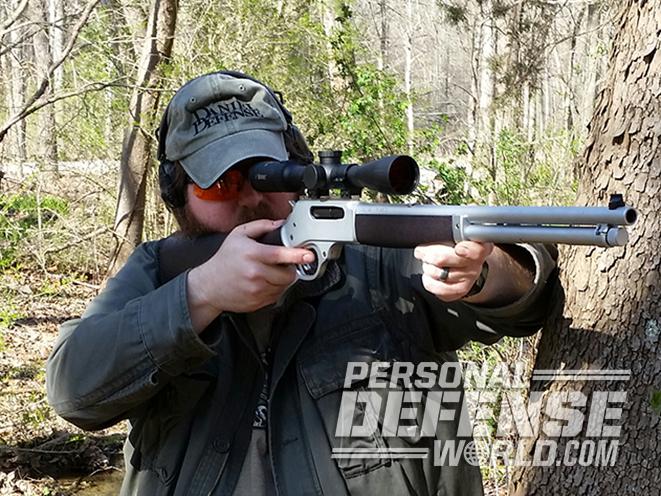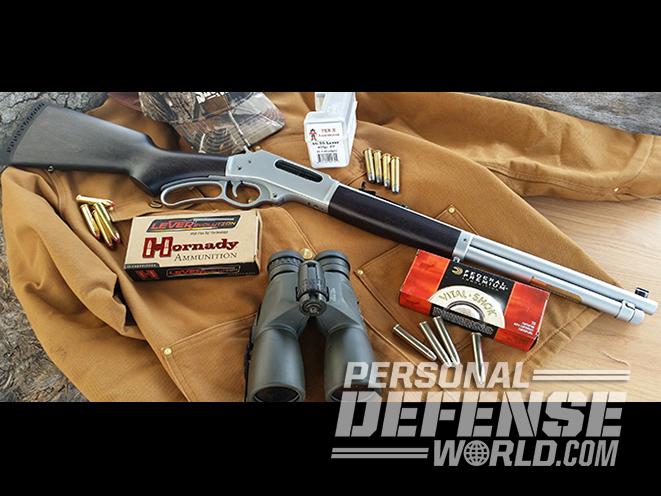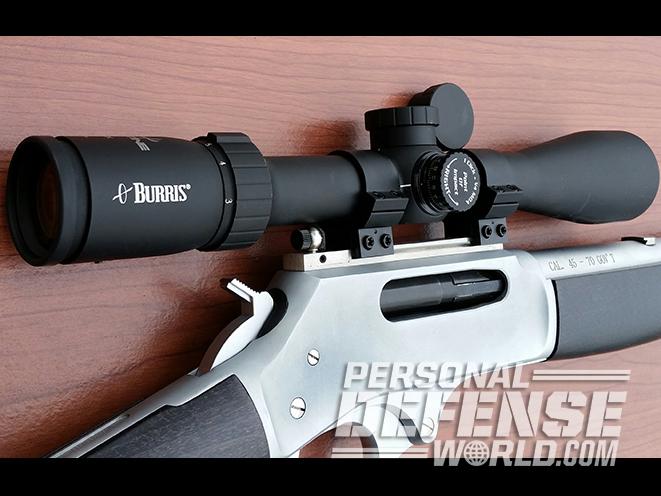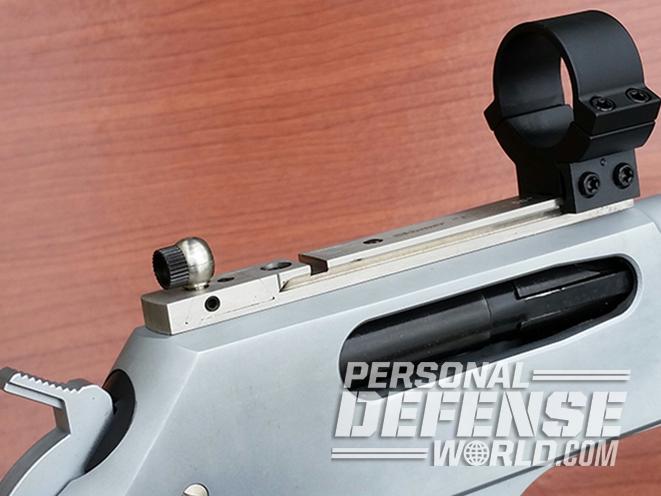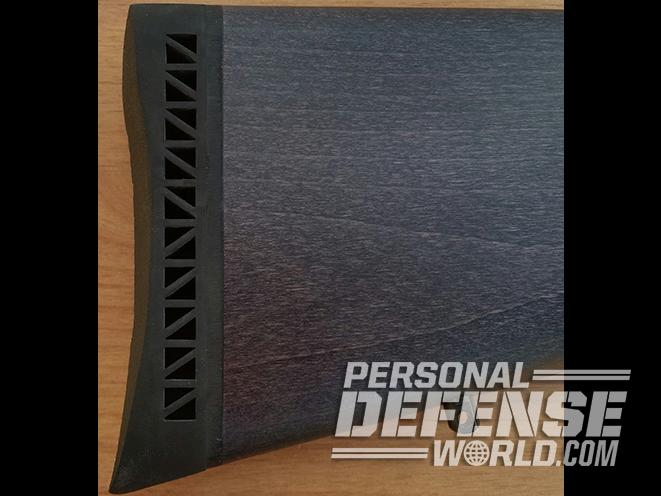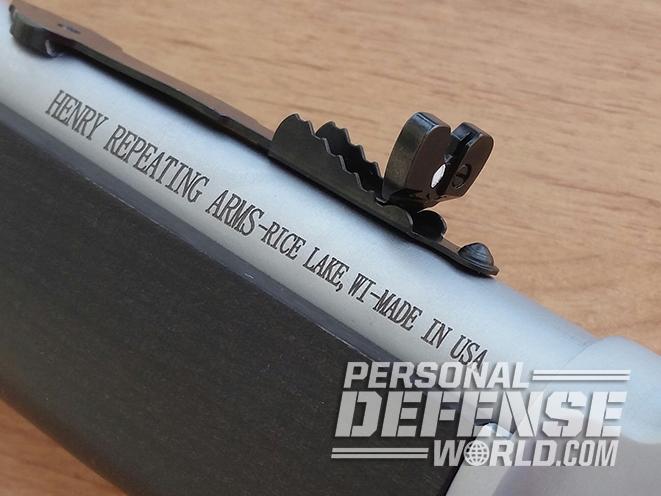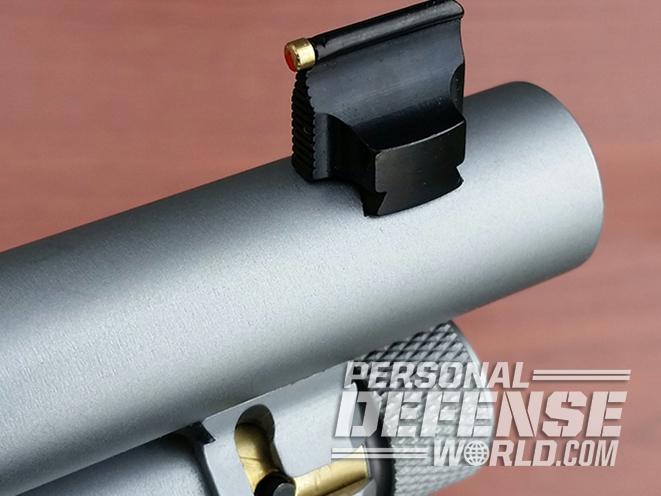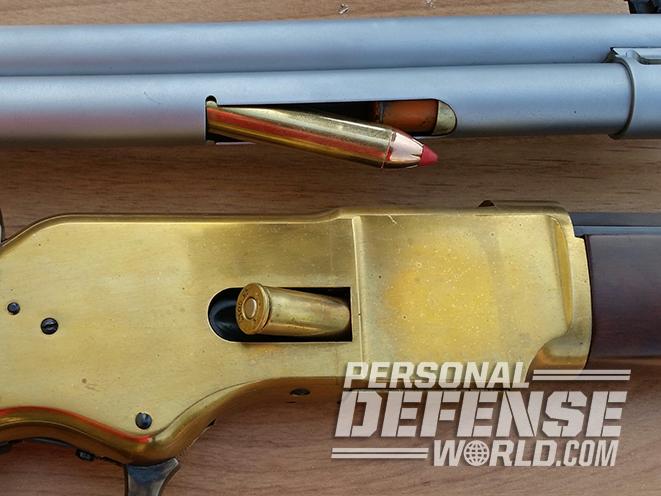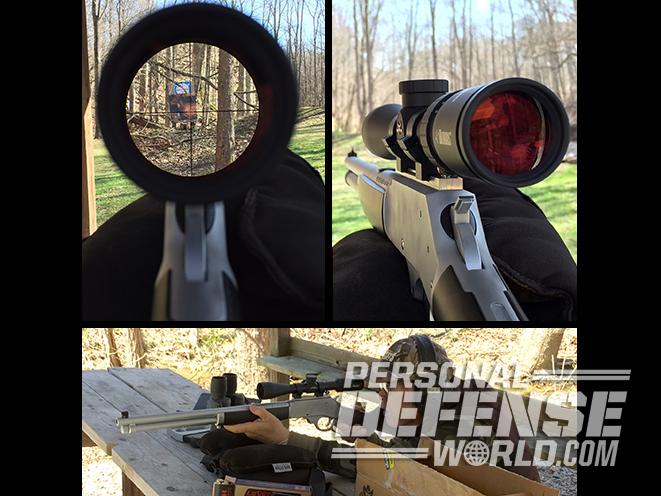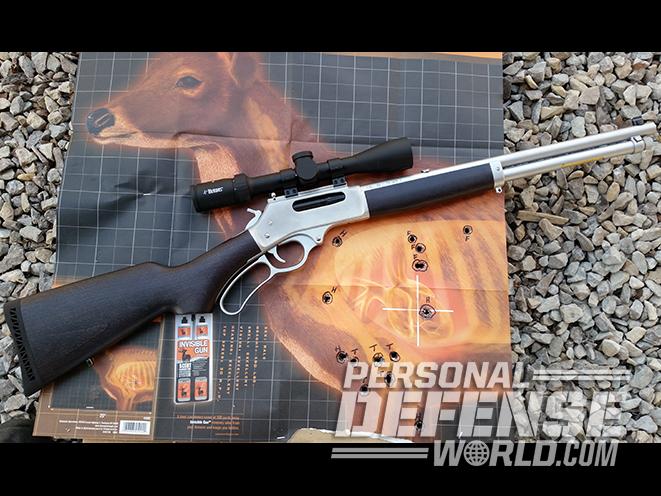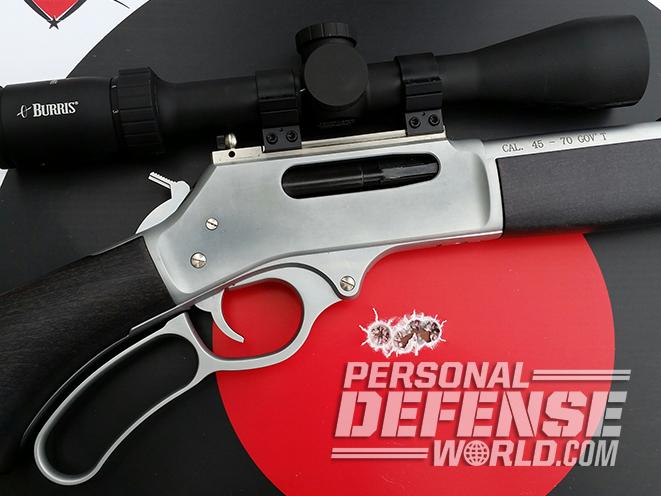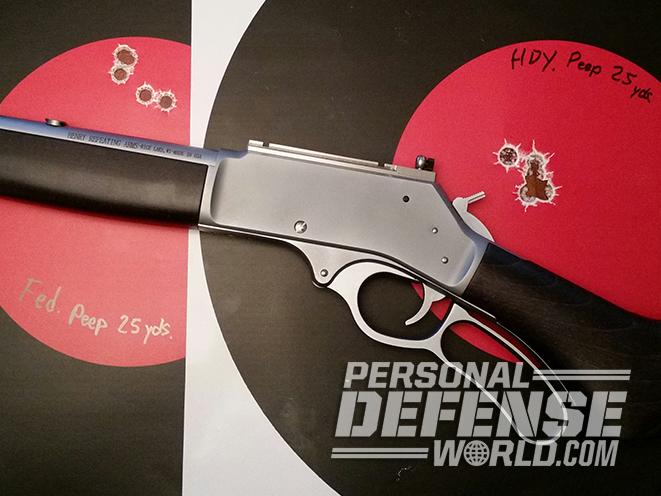Henry Repeating Arms brought the Henry name back into the firearms business in 1996 with the introduction of the American-made Golden Boy, a lever-action .22 LR rifle with a shiny, gold-colored receiver, a blued barrel and magazine tube, and a walnut stock. Since that time, Henry has expanded into the centerfire rifle market with long guns suitable for Cowboy Action Shooting (CAS), hunting and general utilitarian outdoors use. One of the latest offerings in this last category is the Henry All-Weather.
This full-sized rifle has a carbine-length barrel and comes in two configurations: the Model H009AW in .30-30 with a straight-wrist stock and the Model H010AW in .45-70 Government with a pistol-grip stock. Both have the same metal and wood finish treatment, but I opted to try out the Henry All-Weather in .45-70, a big hard-hitting, brush-bucking cartridge that will really get the job done.
Henry All-Weather
The Henry All-Weather has hard chrome plating on all of its steel parts, except for the bolt, internal springs and sights. The hardwood buttstock and forend have a durable, black-colored coating. These special finishes will stand up to the wear and tear of a working firearm and allow the gun to operate in any environmental condition with reliability and accuracy.
Advertisement — Continue Reading Below
The hard chrome that gives the All-Weather the look of brushed stainless steel is permanently bonded to the steel and won’t chip, flake or peel, making it even more rust resistant than some stainless steels. The hardwood stock has a unique coating that’s designed to resist scratching, and it will stand up to moisture and temperature variations that can cause warpage.
The All-Weather .45-70 that I received for testing appeared to be well made with excellent attention to detail. It does look rather unconventional, but looks aside, it was built to stand up to use—and a certain amount of undue abuse—in many different conditions. The two most noticeable features of the Henry are the large ejection port on the left side of the receiver and the loading port. Side ejection makes it easy to add optics, and the top of the receiver is drilled and tapped for this application.
The other feature harkens back to the Civil War era, when the first Henry rifle was introduced. Rather than loading the magazine from a gate in the side of the receiver, the All-Weather has a loading port in the magazine tube. The steel ring that supports and attaches the magazine tube near the muzzle also has an integral locking notch where a pin in the inner magazine tube locks. The magazine tube’s knurled cap is used to turn the tube and unlock it, allowing the tube to be drawn forward and out, opening up the loading port. Cartridges are dropped base-first into the port for loading. The tube is then pressed back in and secured. The magazine for the .45-70 All-Weather holds four rounds.
Advertisement — Continue Reading Below
Mounted in a dovetail about half an inch from the muzzle, the front sight is a tall, blued post with a brass bead that has a small red dot in its center. Right below the bead, the post is serrated, and this front sight is very easy to pick up for fast target acquisitions. Also mounted in a dovetail, the semi-buckhorn rear sight is step-adjustable for windage, and the sight notch can be raised and lowered for elevation. A white diamond directs the eye to the rear sight notch.
Like many lever guns, the All-Weather has no manual external safety, but an internal transfer bar safety mechanism prevents the gun from being fired unless the hammer is fully cocked and the trigger intentionally pulled.
With the hammer at rest or even if the hammer slips from the thumb while cocking, the gun won’t go off. It can be carried safely with a round in the chamber and the hammer fully lowered—there is no half-cock position. The spur is serrated for a good thumb purchase while cocking.
Advertisement — Continue Reading Below
Fitted to the buttstock is a black rubber recoil pad with the Henry name and logo on the back portion. The back is also textured to help hold the rifle securely against your shoulder. About 3.5 inches ahead of the toe of the buttstock and on the bottom of the steel forend cap are studs for mounting sling swivels. This is a great way to carry the 7.08-pound All-Weather.
The finger lever curves downward, following the contours of the pistol grip, and the built-in triggerguard is big enough for gloved hands to activate the trigger. The trigger itself is wide and smooth-faced with an average pull weight of 5.5 pounds. I noted a tiny bit of creep before the sear was released, but there was no significant overtravel.
Sights & Glass
Given this rifle’s intended uses, I wanted it to be as versatile as possible, and one area I concentrated on was redundancy in sighting equipment. While the factory sights are sturdy and effective, my aging eyes do better with peep sights or optics, so I decided to add both to the Henry All-Weather.
Advertisement — Continue Reading Below
Skinner Sights makes a peep sight that is also fashioned so it can serve as a scope mount. I ordered a stainless steel Express sight, which came with a black, 0.096-inch aperture. The rest of the sight has a brushed satin finish, which makes it look like it was made just for the All-Weather. All I had to do was take the tap screws out of the Henry receiver and screw on the Skinner Express sight using the mounting screws that were provided. The sight is adjustable for windage and elevation. The sight also came with a set of medium-height, all-steel Brownells/Warne 7.3 Series scope rings for 1-inch scope tubes.
For glass, I chose a Burris Droptine 3-9x40mm riflescope. Measuring 12.2 inches long and weighing 13 ounces, it has a Ballistic Plex reticle and Hi-Lume-coated lenses for better low-light performance and glare reduction. The turret knobs are protected by screw-on caps, and “steel on steel” adjustments ensure repeatable accuracy. The solid scope tube is nitrogen filled to prevent internal fogging, and it’s durable enough to withstand heavy shocks.
Rounds Downrange
I chose three different factory cartridges in .45-70 to test the Henry All-Weather, including rounds that would be useful on medium to large game animals or other dangerous targets, so the first was Federal’s Vital-Shok ammo. These rounds have nickel-plated cartridge cases and are topped with 300-grain Trophy Bonded Bear Claw bullets that expand reliably and retain 95 percent of their weight in even the toughest of targets. Next up was Hornady’s 325-grain LeveRevolution FTX ammo, which is designed for safe use in tubular magazines while offering superb terminal ballistics. For a general shooting load, I selected “cowboy cartridges” from Ten-X Ammunition with 405-grain lead flat-nose (LFN) bullets.
Advertisement — Continue Reading Below
After zeroing the Burris scope in at 50 yards, I cranked it up to 6X to tackle some 17-inch-diameter targets with big red bullseyes. Some .45-70s can be painful to shoot—especially if they have crescent buttplates—so I pressed the Henry’s trigger with some trepidation, which may account for some of my larger groups, plus a small dose of the “4+1 Syndrome.” My best official five-shot group measured 0.98 inches with the Hornady ammo, and it also gave the smallest group average at 1.2 inches. With the Federal rounds, I had a tight kidney-shaped four-shot group that measured just 0.76 inches, but a flyer opened it up to 1.74 inches. The group average was 1.58 inches. The same thing happened with the Ten-X ammo; a nasty flyer pushed a 1.13-inch four-shot group out to 2.84 inches. The average group size for this load was 2.39 inches.
Practical Testing
For some “practical” shooting, I placed an anatomical deer target slightly uphill and behind some light cover to see how well the big .45-70 bullets would blast through light brush. With the All-Weather loaded, I walked up a little creek to a spot around 70 yards from the target and then engaged it from a standing, off-hand position as if I’d been hunting and suddenly spotted my quarry. I did this three times using all three ammo brands. While I thought my aiming point would put the bullets in the boiler room, most of my shots were either too high or too low. My son, Jordan, was helping me that day, and he took a turn and scored the only heart shot. Lesson learned here: Practice, practice, practice before you go out into the field after game! If you can find a rest, that will definitely help, too.
- RELATED STORY: 10 Ultra-Reliable Lever And Pump-Action Rifles
The last thing I did was remove the scope to see how the All-Weather would do using just the Skinner Express peep sight. I moved the bullseye targets to 25 yards, and using a bench, was pleasantly surprised when the five-shot groups impacted darn close to the point of aim. The windage was pretty much right on, and the elevation varied just a bit with bullet weight. One five-shot group with the Hornady ammo measured 1.19 inches, and second place went to the Federal load with a 1.52-inch cluster. Had time not been a factor that day, I might’ve tested the All-Weather at longer distances.
Advertisement — Continue Reading Below
Field Ready
Along with its handy size and weight, I was very pleased with the accuracy potential of the Henry All-Weather. The wood and metal finishes are certainly durable, and I was relieved to find the recoil pad did a fine job.
Any negatives? The most glaring was the inner magazine tube and locking mechanism. There had to have been rough places inside the outer magazine tube, as the brass inner tube was scored and very difficult to pull out or even to turn and unlock for removal. I also would assume that “All-Weather” would imply checkering on the pistol grip and forend, as wet wood can be very slippery. However, that being said, I think the Henry All-Weather will make the perfect companion for big-game hunting, wandering in the woods or any just-in-case scenario.
- Caliber: .45-70
- Barrel: 18.43 inches
- OA Length: 39 inches
- Weight: 7.08 pounds (empty)
- Stock: Hardwood
- Sights: Bead front, adjustable semi-buckhorn rear
- Action: Lever
- Finish: Hard chrome
- Capacity: 4+1
- MSRP: $1,000
For more information, visit henryusa.com.
Advertisement — Continue Reading Below
